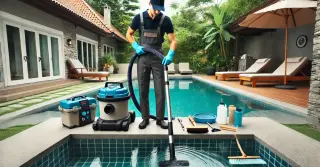Pool Chemical Balance Thomaston GA

Keeping your pool's chemical balance in check is essential for a safe and enjoyable swimming experience. Correct chemical levels stop algae and bacteria growth, keep the water clear and clean, and protect the pool's surface and equipment.
- Balancing pH Levels: The pH level of your pool water indicates its acidity or alkalinity. A balanced pH level should be between 7.2 and 7.6. Low pH levels result in acidic water, causing skin irritation and equipment corrosion. High pH levels make the water alkaline, leading to cloudiness and scaling. Regularly testing and adjusting the pH levels is vital for swimmer comfort and safety.
- Keeping Chlorine Balanced: Chlorine is essential for pool hygiene, as it kills bacteria, algae, and other harmful microorganisms. The proper chlorine level is between 1-3 ppm. Too little chlorine can lead to unsanitary conditions, allowing bacteria and algae to thrive. Too much chlorine can cause skin and eye irritation and produce a strong chlorine odor. Regularly testing and adjusting chlorine levels maintains sanitation and comfort.
Balancing AlkalinityTotal alkalinity plays a vital role in pool water balance. Alkalinity buffers pH levels, helping to prevent drastic changes in pH. The ideal range for total alkalinity is between 80-120 ppm.
- Preventing pH Swings: Balanced alkalinity stabilizes pH levels, preventing rapid pH shifts that cause skin irritation and surface damage. Low alkalinity causes pH levels to fluctuate, making balance maintenance challenging. High alkalinity causes cloudy water and scaling. Consistently monitoring and adjusting alkalinity levels is essential for maintaining a stable and balanced pool.
- Balancing Calcium Levels: Calcium hardness measures the dissolved calcium in water. The ideal range for calcium hardness is between 200-400 ppm. Low calcium levels result in corrosive water, harming surfaces and equipment. If calcium levels are too high, it can cause scaling on pool surfaces and cloud the water. Regularly testing and adjusting calcium hardness is essential for pool protection and clear water.
Using Pool Chemicals SafelyHandling and storing pool chemicals properly is vital for safety and chemical performance. Keep chemicals in a cool, dry location, away from direct sunlight, children, and pets. Adhere to manufacturer guidelines for dosing and application.
- Proper Chemical Measurement and Mixing: Accurately measuring pool chemicals is crucial for maintaining balance. Using too much or too little can imbalance chemicals and harm water quality. Always use a clean, dry measuring cup or scoop and never combine chemicals directly. Mix chemicals in water if required, following the instructions carefully.
- Awareness of Chemical Reactions: Certain chemicals can react dangerously if mixed. For example, chlorine and acid should never be mixed. Being aware of these interactions avoids accidents and ensures safe use. Store chemicals apart and handle each carefully to prevent harmful reactions.
Keeping your pool's chemical balance is crucial for safety, cleanliness, and enjoyment. By regularly testing and adjusting pH, chlorine, alkalinity, and calcium levels, you ensure optimal water quality.
Safe handling and storage of pool chemicals enhance the health and safety of your pool.




